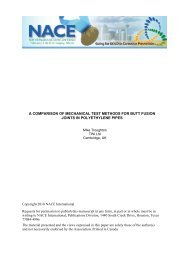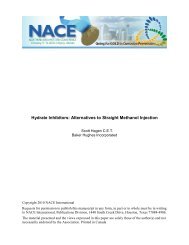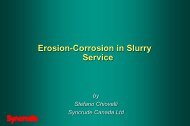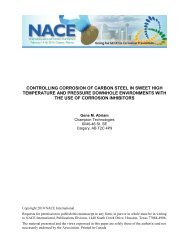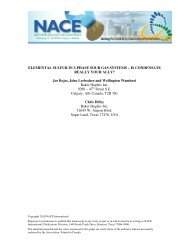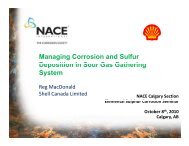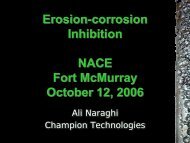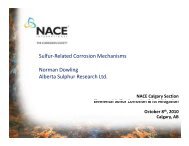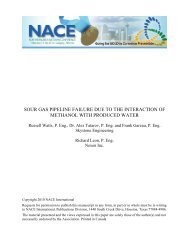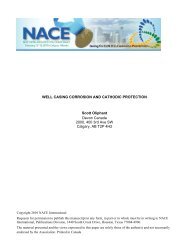Downhole Corrosion Mechanisms and Mitigation ... - NACE Calgary
Downhole Corrosion Mechanisms and Mitigation ... - NACE Calgary
Downhole Corrosion Mechanisms and Mitigation ... - NACE Calgary
Create successful ePaper yourself
Turn your PDF publications into a flip-book with our unique Google optimized e-Paper software.
<strong>Downhole</strong> <strong>Corrosion</strong> <strong>Mechanisms</strong><br />
And <strong>Mitigation</strong> Strategies<br />
Don McDougall – Sr. Product Manager<br />
<strong>NACE</strong> <strong>Corrosion</strong> Technologist<br />
<strong>NACE</strong> Northern Area<br />
Integrity Management Seminar<br />
April 22, 2010<br />
Days Inn <strong>and</strong> Conference Center<br />
Estevan, SK
DEFINITION<br />
CORROSION is defined as:<br />
The deterioration of a substance (usually<br />
a metal) or its properties because of a<br />
reaction with its environment.
<strong>Corrosion</strong> Accelerators
<strong>Corrosion</strong> - General<br />
It is the physical condition of the metal at the anode<br />
that initiates the corrosion process. ( Metal Loss<br />
occurs at the Anode. )<br />
However, it is the:<br />
CHEMISTRY <strong>and</strong> COMPOSITION of the electrolyte<br />
that controls the rate of the corrosion reaction <strong>and</strong><br />
the severity of the corrosion.
CORROSION RATE Accelerators<br />
‣ Dissolved Gases<br />
‣ Oxygen<br />
‣ Acid Gases = H 2 S <strong>and</strong> CO 2<br />
‣ pH<br />
‣ Salinity / Conductivity<br />
‣ Flow<br />
‣ Temperature<br />
‣ Solids ( Iron Sulfides & Sulfur )
Oxygen <strong>Corrosion</strong><br />
By far the most corrosive gas in oil field waters is<br />
DISSOLVED OXYGEN<br />
It does this by two mechanisms:<br />
• The formation of oxygen concentration cells<br />
• Cathodic <strong>and</strong> Anodic depolarizer<br />
• Chemical reactions occur at both the anode <strong>and</strong> cathode<br />
• These chemical reactions speed up the corrosion process
One of the most common locations to find evidence of<br />
OXYGEN CORROSION, is in the exposed threads near<br />
the make-up of tubing or pipe sections.<br />
Since the "troughs" in the thread patterns are generally oxygen depleted, the<br />
thread points can exhibit loss of metal at their bases. Many times these<br />
threads will flake off on inspection of failed joints.
The most common locations for<br />
OXYGEN CORROSION<br />
Producing Systems<br />
• leaking stuffing boxes on rod pumps<br />
• leaking vents on produced fluid tanks<br />
Water Injection Systems<br />
• leaking packings on pumps (any time a transfer pump or<br />
water injection pump is leaking water out it is leaking air in)<br />
• leaking vents on water storage tanks
Oxygen <strong>Corrosion</strong><br />
In general, it is easier to repair the leak to<br />
control the corrosion that is caused when<br />
the oxygen dissolves in the water than it is<br />
to try to chemically control the corrosion.
Oxygen <strong>Corrosion</strong>
Oxygen <strong>Corrosion</strong><br />
•Oxygen will accelerate other corrosion effects.<br />
•When present at concentrations as low as 50 ppb, in<br />
the presence of any of the Acid Gases, corrosion rates<br />
will be accelerated significantly.<br />
•Because of this phenomenon, Oxygen Accelerated<br />
<strong>Corrosion</strong> is often misinterpreted in the oil field.<br />
•<strong>Corrosion</strong> rates have been known to increase by as<br />
much as 100 times.
Oxygen Accelerated <strong>Corrosion</strong><br />
Stuffing Box<br />
O 2 Leakage in Sour Brine<br />
Corroded Stuffing Box
Acid Gases<br />
The next most corrosive gas is carbon dioxide<br />
followed by hydrogen sulfide.<br />
The corrosivity of both of these gases is a function<br />
of their ABILITY TO FORM HYDROGEN IONS.
Acid Gas <strong>Corrosion</strong><br />
CARBON DIOXIDE<br />
HYDROGEN SULFIDE<br />
Both of these gases contribute to corrosion by increasing the<br />
acidity of the water when they dissolve in it.<br />
H 2 O + CO 2 H + + CO 3<br />
-2<br />
H 2 O + H 2 S H + + HS -<br />
hydrogen ions
Carbon Dioxide <strong>Corrosion</strong><br />
The corrosion by-product is iron carbonate also known as siderite.<br />
Water<br />
Dissolved CO 2<br />
hydrogen gas<br />
iron carbonate<br />
H+<br />
Fe++<br />
ANODE<br />
2e-<br />
CATHODE
CO 2 <strong>Corrosion</strong> Rate in Distilled Water<br />
(As Extrapolated from Chart - “OilField Water Systems” by Patton)<br />
Partial Pressure = (Mole % CO2 X System psi) / 100<br />
Example: (3% CO 2 X 150 psi) / 100 = 4.5
CO 2 <strong>Corrosion</strong>
Hydrogen Sulfide <strong>Corrosion</strong><br />
The corrosion by-product is iron sulfide. The<br />
initial crystalline form of iron sulfide is makinawite.<br />
Water<br />
Dissolved H 2 S<br />
hydrogen gas<br />
iron sulfide<br />
H+<br />
Fe++<br />
ANODE<br />
2e-<br />
CATHODE
H 2 S <strong>Corrosion</strong><br />
Cracking Evident
<strong>Corrosion</strong> Rate ( mpy)<br />
30<br />
25<br />
20<br />
15<br />
10<br />
5<br />
General <strong>Corrosion</strong> Rate Comparison<br />
O2<br />
H2S<br />
CO2<br />
Dissolved Gas ( ppm )<br />
0<br />
O 2 1 2 3 4 5 6 7 8<br />
CO 2 50 100 150 200 250 300 350 400<br />
H 2 S 100 200 300 400 500 600 700 800<br />
Excerpt taken from:<br />
“<strong>Corrosion</strong> <strong>and</strong> Water Technology for Petroleum Producers”<br />
Loyd W. Jones
Effects of pH<br />
‣ High <strong>Corrosion</strong> rates from pH 1 to 5 <strong>and</strong><br />
again from pH 11 to 14<br />
‣ Moderate to low corrosion rates from<br />
pH 5 to 11<br />
‣ Passive Zone = pH 9 - 10<br />
Severe<br />
High<br />
Moderate<br />
Low<br />
1 2 3 4 5 6 7 8 9 10 11 12 13 14
Effects of Salinity<br />
‣ As a general statement<br />
‣ The higher the salinity - the higher the<br />
conductivity.<br />
‣ The higher the conductivity - the higher<br />
the corrosion rate.<br />
‣ Not really an issue unless any of H 2 S, CO 2<br />
or O 2 are present.
Effects of Flow<br />
‣ Low Flow – Stagnant to Laminar<br />
‣ Solids have a chance to accumulate on the bottom of<br />
the line increasing the chance for Under deposit<br />
corrosion.<br />
‣ Moderate –<br />
‣ Moderate flow is required to transport the Inhibitor<br />
through the system as well as keep the solids from<br />
accumulating on the bottom if the lines.<br />
‣ High Flow – Turbulent or Slug<br />
‣ The high flow rates are more susceptible to corrosion.<br />
More areas for pressure differentials.<br />
‣ The <strong>Corrosion</strong> byproducts are removed from the<br />
corroding sites ( anodes ) exposing fresh metal to its<br />
environment.<br />
‣ Annular Flow<br />
‣ In Gas systems where liquids exist as entrained<br />
droplets.
Types of Phase Flow
CO 2 <strong>Corrosion</strong><br />
Accelerated by FLOW
Effects of Temperature<br />
It should be noted that corrosion rates<br />
generally DOUBLE with every increase of<br />
10 degrees (Centigrade) in temperature.
Effects of Solids Accumulation<br />
The area under a Solids Accumulation<br />
becomes Anodic to the surrounding<br />
base metal.<br />
• Metal loss occurs at the Anode, therefore<br />
under deposit corrosion is more likely.<br />
Solids accumulations can reduce<br />
corrosion inhibitor performance.<br />
• Surface area is increased substantially
CORROSION RATES<br />
‣ Oxygen<br />
‣ Acid Gases<br />
‣ pH<br />
‣ Salinity / Conductivity<br />
‣ Flow<br />
‣ Temperature<br />
‣ Solids Accumulations<br />
‣ EFFECTS ARE ADDITIVE
<strong>Corrosion</strong><br />
Magnitude
RP0775-2005 <strong>Corrosion</strong> Rates<br />
General<br />
mpy<br />
Pitting<br />
mpy<br />
<strong>Corrosion</strong><br />
Rating<br />
< 1.0 < 5.0 Low<br />
1.0 – 4.9 5.0 – 7.9 Moderate<br />
5.0 – 10.0 8.0 – 15 High<br />
> 10.0 > 15.0 Severe<br />
1 mpy = 0.001” per year
<strong>Downhole</strong> <strong>Corrosion</strong> SW Sask
<strong>Mitigation</strong> Strategies<br />
Material Design<br />
Coatings<br />
Chemical Inhibition
Material Selection<br />
<strong>Corrosion</strong> Resistant Metal Alloys<br />
• Monel, Inconel, Hastaloy<br />
• Pump Parts<br />
Fiberglass<br />
• Sucker Rod Material
Coatings<br />
There are many Epoxy type coating<br />
available<br />
Most often used in Water Injection<br />
wells
Chemical Additives<br />
Hydrogen Sulfide Scavengers<br />
• Remove corrosive H 2 S<br />
Oxygen Scavengers<br />
• Remove corrosive Oxygen<br />
<strong>Corrosion</strong> Inhibitors<br />
• More to follow…
CHEMICAL CORROSION<br />
INHIBITORS<br />
Chemicals injected in small concentrations<br />
• ( 50 ppm to 500 ppm +)<br />
Physically adsorb onto the metal surface<br />
as a mobile film <strong>and</strong> reduce the cathodic<br />
reactions<br />
Often combine with corrosion byproducts<br />
to form a passive protective layer
Oilfield <strong>Corrosion</strong> Inhibitors<br />
Polar Molecules<br />
Typically Amine Based<br />
Have an attraction to surfaces, especially<br />
Iron<br />
Tend to “Oil Wet” the equipment to provide a<br />
barrier to the corrosive fluids.<br />
CONTAIN:<br />
Inhibitor compounds ( sometimes 2 or 3 )<br />
blended with Surfactants, Demulsifiers,<br />
Partitioning Agents.
Oilfield <strong>Corrosion</strong> Inhibitors<br />
‣ Most Oilfield <strong>Corrosion</strong> Inhibitors are<br />
capable of controlling H 2 S, CO 2 <strong>and</strong><br />
Organic Acid <strong>Corrosion</strong><br />
‣ Blended for specific applications<br />
‣ Specialized chemicals are required for<br />
‣Oxygen Accelerated <strong>Corrosion</strong><br />
‣Systems with Elemental Sulfur<br />
‣Aluminum Flow-Lines<br />
‣Atmospheric <strong>Corrosion</strong> Protection
Oilfield <strong>Corrosion</strong> Inhibitors<br />
‣Water Based, Oil Based<br />
‣All are Water Dispersible to some degree<br />
‣Cleaning Capability<br />
‣Increased by the Surfactant Additives<br />
‣Surfactants are designed to remove<br />
loose solids accumulations
Oilfield <strong>Corrosion</strong> Inhibitors<br />
<strong>Downhole</strong> Application Techniques<br />
‣ Continuous Injection<br />
‣ Dribble down the annulus<br />
‣ Capillary Injection String<br />
‣ Batch & Circulate<br />
‣ Circulate <strong>and</strong> Park<br />
‣ Tubing Displacement
Oilfield <strong>Corrosion</strong> Inhibitors<br />
Amine<br />
Sweetening<br />
Dry<br />
Gas<br />
Compressor<br />
Cooler<br />
Glycol<br />
Dehydrator<br />
Producing<br />
Wells<br />
FWKO<br />
Scrubber<br />
Heater<br />
Treater<br />
Oil Storage<br />
Tank<br />
Injection<br />
Well<br />
Water<br />
Clarifier<br />
Pump<br />
Surge<br />
Vessel<br />
Water<br />
Storage<br />
Tank<br />
Source<br />
Water
Oilfield <strong>Corrosion</strong> Inhibitors<br />
How do they work??
<strong>Corrosion</strong> Inhibitors<br />
N<br />
N<br />
Large Lipophilic Tail<br />
( Likes Oil )<br />
Relatively Small Lipophobic End<br />
( Dislikes Oil )<br />
( Strong attraction to surfaces )
Uninhibited Corrosive System<br />
Electrolyte<br />
2OH -<br />
Fe ++ Fe ++ 2H + e - hydrogen gas<br />
Conductor<br />
anode<br />
e -<br />
cathode
Inhibited Corrosive System<br />
The <strong>Corrosion</strong> Inhibitor becomes a barrier between the<br />
metal surface <strong>and</strong> the electrolyte, thereby controlling corrosion.<br />
Mobile <strong>Corrosion</strong><br />
Inhibitor Film<br />
Electrolyte<br />
Anode<br />
Cathode<br />
Conductor
Pipe with Oily Film<br />
( Crude Oil, Paraffins )<br />
Mobile <strong>Corrosion</strong><br />
Inhibitor Film<br />
Oily Film<br />
Electrolyte<br />
Anode<br />
Conductor<br />
Cathode<br />
Anode
Effects of Loose Solids<br />
on the Pipe<br />
<br />
<br />
The area directly under a deposit becomes Anodic to the<br />
surrounding metal<br />
• Metal Loss occurs at the Anodic Sites<br />
• <strong>Corrosion</strong> Potential is increased<br />
<strong>Corrosion</strong> Inhibitor cannot get to the pipe!!<br />
2H +<br />
hydrogen gas<br />
Fe++<br />
ANODIC<br />
2e -<br />
CATHODIC
Pipe with Loose Solids<br />
( Iron Sulfide Clumps, Scale, Silt, S<strong>and</strong> )<br />
Mobile <strong>Corrosion</strong><br />
Inhibitor Film<br />
Electrolyte<br />
Anode<br />
Cathode<br />
Anode<br />
Cathode<br />
Anode<br />
Cathode<br />
Anode<br />
Cathode<br />
Anode<br />
Cathode<br />
Anode<br />
Cathode<br />
Anode<br />
Anode<br />
Cathode<br />
Anode<br />
Cathode<br />
Anode<br />
Cathode<br />
Anode<br />
Cathode<br />
Anode<br />
Cathode<br />
Anode<br />
Cathode<br />
Anode
<strong>Corrosion</strong> Monitoring<br />
Time Averaged Techniques
Weight Loss Coupons<br />
Coupons come in a variety of shapes, sizes <strong>and</strong><br />
metallurgies …( must match the system)
Installing <strong>Corrosion</strong> Coupons<br />
FLOW
Inhibitor Comparison<br />
Using Coupons<br />
FLOW<br />
35 ppm<br />
Water Soluble Chemical<br />
35 ppm 25 ppm<br />
Oil Soluble Chemical
Time Averaged - Cumulative Techniques<br />
DIRECT WALL THICKNESS MEASUREMENTS:<br />
• Ultrasonic - wall thickness measurements<br />
• Wireline – Magnetic Flux Leakage Tool
Magnetic Flux Leakage
Time Averaged - Cumulative Techniques<br />
• Copper Ion Displacement Test<br />
• Used to determine whether a <strong>Corrosion</strong><br />
inhibitor film is still present on the metal<br />
surface.<br />
• Particularly effective in evaluating a film<br />
life on a <strong>Corrosion</strong> Inhibitor Batch<br />
program. Insert multiple coupons in a<br />
system <strong>and</strong> pull them one per week <strong>and</strong><br />
see if the inhibitor film is still intact.
Copper Ion Displacement Test<br />
• Dip an exposed <strong>Corrosion</strong> Coupon<br />
into a Copper Sulfate solution<br />
(~10%)<br />
• Failure pieces can be flushed with<br />
Copper Sulfate to see if an Inhibitor<br />
film exists.<br />
• Areas of metal exposing bare metal<br />
will film out metallic copper.
FAILURE HISTORY<br />
This type of corrosion monitoring looks at the “Big<br />
Picture“ <strong>and</strong> examines the number of corrosion<br />
related failures that have occurred over a fixed<br />
period of time.<br />
Comparison of trends in failures provides an<br />
overview of the status of the corrosion control<br />
program.
Time Averaged - Cumulative Techniques<br />
FAILURE HISTORY SHOULD INCLUDE:<br />
• Number <strong>and</strong> frequency of corrosion related failures<br />
• Failures/Well/Year<br />
• Run Time per well<br />
• Cause Analysis<br />
• Physical Conditions- Flow rates, Water to Oil<br />
Ratios, Temperatures, Dissolved Gases,<br />
Chlorides in water etc.<br />
• Plot on a Field Map / Plant Diagram
Instantaneous Techniques<br />
Iron Counts --- <strong>NACE</strong> RP0192-98<br />
• Analyze the water for changes in Iron Content<br />
• Total Iron ( Acidized with Iron Free Acid )<br />
• Samples from a given system must be h<strong>and</strong>led<br />
the same way each time in order for the data to<br />
be meaningful.<br />
• Data should be expressed as Kg/Day iron based<br />
on daily water production – especially useful for<br />
systems with fluctuating volumes.
Instantaneous Techniques<br />
Iron Counts --- <strong>NACE</strong> RP0192-98<br />
• Manganese is usually tested at the same time.<br />
• Carbon Steel contains 1% Mn<br />
• Most formations contain no Mn.<br />
• Iron Counts from Sour systems are not as reliable<br />
as those taken from Sweet systems.<br />
• Iron Sulfides have a low solubility in water.<br />
• A few flakes of rogue Iron Sulfide can easily contaminate<br />
a water sample making the results suspect.
Failure Analysis
<strong>Corrosion</strong> Failure
.<br />
FAILURE ANALYSIS<br />
The ability to analyze samples of failed materials lends<br />
toward a better underst<strong>and</strong>ing of the<br />
“CAUSE OF THE FAILURE “<br />
FAILURE ANALYSIS is a crucial part of designing any<br />
successful corrosion control program.




